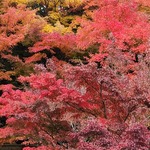Longtime UNS Member, Sharon Meyers, is currently living in Japan for several months. This is a glimpse into her world and journey.
Autumn’s wind whispers,
leaves rustle under my feet
red, gold hued splendor
Komorebi cannot be translated directly, as it is not a word, but a feeling that reflects the emotional love of the Japanese for nature. It is an expression of a fleeting moment, “lost in translation” into any English word. The best way to describe this sentiment is by explaining the transient beauty of komorebi – when the sun glistens through the leaves and just for a moment, they sparkle. I experienced komorebi this week, in climbing through forest to a temple with a panoramic vista, ablaze with autumn color. As I took the last few steps up, the beauty and wonder of light rays dappling through overhead trees, casting dancing shadows on the forest floor, invited me to take notice. Others did as well. We all stopped, silent and smiling. It brought to mind my first experience of Kyoto in autumn in my mid-twenties, that remains so vivid in images of brilliant color, the sound of wind, and even the scent of smoky, musty fallen leaves.
Japanese culture appreciates the moment, and often with noticeable delight. While forest bathing is a ritual meditation, forest gazing, known as momijigari/ leaf viewing, is a “nature as art” tradition. It is so important that locals dress in formal kimono, capturing photos of the vibrant foliage (and themselves in it) to share with their loved ones. Color is such an enveloping experience, and in a culture that values subtlety, this is an awakening of the senses of celebration that is palpable. Right now Kyoto is bursting in a riot of color; we are simply enchanted.
When was the last time you smiled in pure pleasure of a sensory experience of sight, sound, and scent without explanation of words, just experience of the moment?
Arigato,
Sharon
Weekly Recipe
A classic of Japanese home cooking, this dish offers a tasty twist to eggplant, with just a few ingredients. Served hot, it pairs nicely with rice and a dash of Furikake seasoning.
Nasu Dengaku
Serves 2
Ingredients:
1 medium eggplant,
1 T each miso and mirin
1 tsp each sake (or white wine), sugar and toasted sesame oil.
To Make:
-Slice eggplant lengthwise into longitudinal strips about 1/4" depth, and cut into the flesh slightly to make a crisscross pattern; brush with oil
-Roast at 400 degrees for about 15 to 20 minutes, until the flesh is a slightly browned and fork tender
-While the eggplant is in the oven, whisk miso, mirin, sake and sugar into a small bowl until well blended
-When eggplant is golden and tender, brush the glaze evenly on top and broil for just a few minutes until the top caramelizes and bubbles







